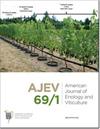在欧洲采用新的酿酒葡萄品种以减少农药的使用
IF 1.8
3区 农林科学
Q3 BIOTECHNOLOGY & APPLIED MICROBIOLOGY
引用次数: 0
摘要
背景和目标气候变化导致天气条件越来越恶劣,因此给葡萄种植者带来了新的挑战。在欧洲,日益增加的气候变化导致了各种各样的问题,导致某一年的夏季极度干燥,而下一年则极度潮湿,并伴有高病原体压力。特别是在非常潮湿的年份,葡萄种植需要大量使用农药产品,以防止产量和质量损失。欧盟雄心勃勃的目标是到2030年将农业农药使用量减少50%,这给葡萄种植者带来了进一步的压力。然而,经过一百多年的葡萄育种,有许多抗病品种可供今天的葡萄种植者使用。方法和主要发现本文概述了这些新型抗病葡萄品种在欧洲的发展、它们的优势以及葡萄种植者在使用它们适应气候变化影响条件时面临的问题。对这些新品种的偏见和不确定性导致葡萄种植业的采用率很低。本文将介绍旨在减轻这些疑虑的正在进行的研究。根据葡萄品种和环境条件的不同,抗病葡萄品种可使葡萄种植者减少80%的杀菌剂用量。这些品种是减少葡萄栽培中农药使用的重要组成部分,因此,满足欧盟制定的减少农药使用的要求。本文章由计算机程序翻译,如有差异,请以英文原文为准。
Adoption of New Winegrape Cultivars to Reduce Pesticide Use in Europe
Abstract
Background and goals
Climate change has led to increasingly difficult weather conditions and therefore, new challenges for grapegrowers. In Europe, increasing climatic variability is leading to a variety of problems, causing extremely dry summers in one year and extremely wet conditions accompanied by high pathogen pressure in the next. Especially in very wet years, viticulture requires the extensive use of pesticide products to prevent yield and quality loss. The European Union’s ambitious goal to reduce pesticide usage in agriculture by 50% by 2030 is putting further pressure on grapegrowers. However, after more than one-hundred years of grapevine breeding, there are many disease-resistant cultivars available for today’s grapegrowers.Methods and key findings
This Insight provides an overview on the development of these new disease-resistant cultivars in Europe, their advantages, and the problems that grapegrowers face when using them to adapt to the conditions affected by climate change. Prejudice and uncertainty about these new cultivars has led to a low adoption rate within the grapegrowing sector. Ongoing research that aims to mitigate these doubts will be presented herein.Conclusions and significance
Disease-resistant grapevine cultivars allow grapegrowers to reduce fungicide usage by up to 80%, depending on cultivar and environmental conditions. These cultivars are an important part of the effort to reduce pesticide usage in viticulture and therefore, to fulfill the demands for pesticide reduction set by the European Union.求助全文
通过发布文献求助,成功后即可免费获取论文全文。
去求助
来源期刊

American Journal of Enology and Viticulture
农林科学-生物工程与应用微生物
CiteScore
3.80
自引率
10.50%
发文量
27
审稿时长
12-24 weeks
期刊介绍:
The American Journal of Enology and Viticulture (AJEV), published quarterly, is an official journal of the American Society for Enology and Viticulture (ASEV) and is the premier journal in the English language dedicated to scientific research on winemaking and grapegrowing. AJEV publishes full-length research papers, literature reviews, research notes, and technical briefs on various aspects of enology and viticulture, including wine chemistry, sensory science, process engineering, wine quality assessments, microbiology, methods development, plant pathogenesis, diseases and pests of grape, rootstock and clonal evaluation, effect of field practices, and grape genetics and breeding. All papers are peer reviewed, and authorship of papers is not limited to members of ASEV. The science editor, along with the viticulture, enology, and associate editors, are drawn from academic and research institutions worldwide and guide the content of the Journal.
 求助内容:
求助内容: 应助结果提醒方式:
应助结果提醒方式:


